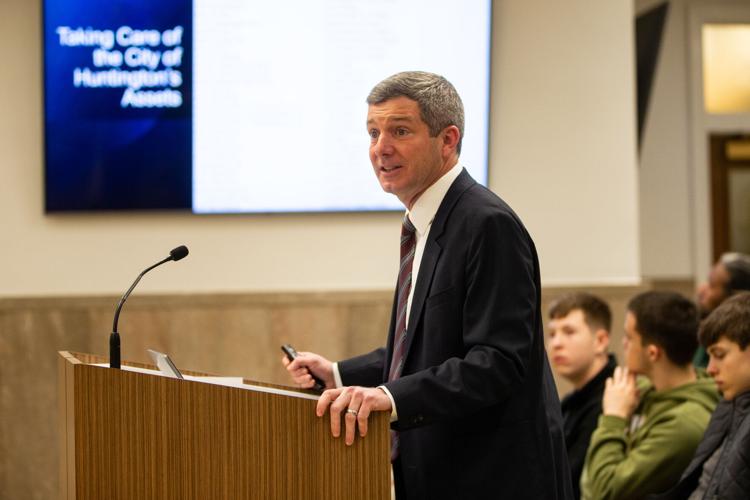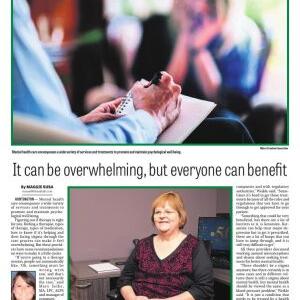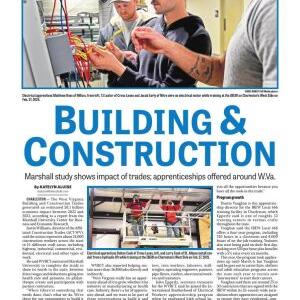Editor's note: This article was updated at 11 a.m. Thursday, Feb. 20, to change inaccurate wording that reflects the police and fire budget, which will receive full funding. A previous version of the article incorrectly indicated police and fire budgets decreased in previous years. The update also includes a change in wording to better reflect the potential loss in funding for some local organizations. More context to lines such as demolition and contributions to the animal shelter and park board were also added.
HUNTINGTON �����Ƶ� Huntington Mayor Patrick Farrell stressed the importance of building a financially resilient city while staying on course with his goals of safety and growth as he discussed his proposed Fiscal Year 2026 budget.
In a 30-minute PowerPoint presentation to Huntington City Council and residents during Monday evening�����Ƶ�s regular council meeting, Farrell gave a detailed message of the current state of the city, highlighting its liabilities and areas that could be improved.
Farrell�����Ƶ�s proposed FY26 budget, which begins July 1, focuses on reeling in expenses as he anticipates funding from federal grants the city has relied on in the past will significantly decrease, such as Coronavirus Aid, Relief, and Economic Security (CARES) or American Rescue Plan Act (ARPA) funding.
Farrell also highlighted less-than-expected funds from opioid settlement funds being distributed by the West Virginia First Foundation. The city will receive the remaining 13 checks; however, rather than each check being around $2.7 million like the first check received in January 2024, Farrell said he now expects all of the checks combined to only amount to $6 million.
�����Ƶ�We�����Ƶ�re excited about the budget,�����Ƶ� Farrell said at a press event Tuesday morning. �����Ƶ�The goals we�����Ƶ�re trying to achieve are to be transparent, data-driven and flexible.�����Ƶ�
Farrell said his goal is to make sure every dollar is spent on the city�����Ƶ�s core priorities while keeping an eye on the long-term financial resiliency of the city.
Farrell said he wants to focus on building financial resilience by rebuilding reserves through disciplined spending and making smart financial choices for stability. Farrell proposed a flat budget of $78 million �����Ƶ� which aligns with the current fiscal year�����Ƶ� that will prioritize essentials. Farrell said he will ensure financial resilience by maintaining cash reserves to cover two months of operating costs and planning proactively for quarterly cash flow challenges.
In his deep dive into the city budget, Farrell said he has found a slow decrease in taxes and fees, which is the city�����Ƶ�s biggest revenue source while federal grant money starts to diminish. This, along with expenses rising over the last five years due to an increase in employees and significantly underbudgeting insurance costs, are key points in focusing on financial resiliency, he said.
�����Ƶ�We currently sit below what I consider to be a healthy benchmark,�����Ƶ� Farrell said. �����Ƶ�There�����Ƶ�s $15 million in back taxes, delinquent fees that the city is owed from our residents that they haven�����Ƶ�t paid us, so while we need cash, we haven�����Ƶ�t been able to collect it.�����Ƶ�
For the upcoming fiscal year, Farrell outlined his essentials as public safety, investing in infrastructure and growing the economy.
His proposed budget gives full funding to police and fire, which is budgeted at $16,160,225 for the police department and $14,465,935 for the fire department. Farrell said the budget will also prepare for rising jail costs and make ground on the Westmoreland Fire Station. The budget will also save money for expected legal costs, he said. Farrell said funds will also go toward the launch of a veteran homelessness pilot program he announced at his inauguration. Farrell said he is unable to estimate the allocation of funds for the veteran homelessness pilot program.
In his top priority for infrastructure, Farrell said he will focus on flooding in the city and neighborhoods. Farrell said he will prioritize working with community partners to help prevent flooding in the long term. His proposed budget allocates money for a second egress route for the Enslow Park neighborhood and upgrades for the city�����Ƶ�s sewer and wastewater infrastructure.
The budget also proposes an increase for demolition of unsafe buildings, data-driven street paving and continuing the path of the city�����Ƶ�s more than $200 million upgrades in stormwater and wastewater.
Huntington Communications Director Evan Lee said in an email last week the fiscal year 2025 budget allocated only $500,000 from the general fund for demolition from July to December. In contrast, the proposed fiscal year 2026 budget increases the amount to $1 million.
"Mayor Farrell has consistently stated that the FY25 spending cut was a mistake that needed to be corrected," Lee said. "This funding increase delivers on his commitment to invest more in demolishing dilapidated properties."
Farrell said he will focus on funding several projects that will bring economic success and growth to the city, such as the revitalization of the Foundry (former ACF site) in Highlawn and partnering with Marshall University for projects in the Innovation District in downtown Huntington. The projects will help bring more people to the area, he said.
A project that is also still in the works and goal of Farrell�����Ƶ�s is Fairfield�����Ƶ�s Northcott Court. While he did not have an update on the project, he said the city will continue to work with developers and Marshall University for plans.
�����Ƶ�Fairfield is very much a priority of ours, and making sure that we can build something that complements the community and can help uplift us, grow jobs and grow the population, including along the Fairfield corridor,�����Ƶ� Farrell said.
�����Ƶ�The idea is that we want to grow the population of Huntington. That will be the sign of ultimate success that we have done something right, that people want to live and work here if we do this right.�����Ƶ�
While striving for �����Ƶ�financial resiliency�����Ƶ� and the precautions of future cut backs in federal grants, Farrell said the city will cut back on its �����Ƶ�community partners.�����Ƶ� Farrell said Tuesday that he is in conversations with all of the organizations that the cuts could affect, including the Cabell County Public Library, the Huntington Cabell Wayne Animal Control Shelter and the Greater Huntington Park and Recreation District.
The contributions fund supports grant-making after the city meets its core obligations, like public works and public safety, Lee said. Previously, higher tax revenues and federal grants allowed for more spending, but with declining revenues and the end of COVID-era grants, budgets are tightening, he said.
�����Ƶ�The city has essential functions that we have to serve. We have a lot of partners that help us with that, that are aligned with our priorities,�����Ƶ� Farrell said. �����Ƶ�We�����Ƶ�re meeting with those partners. We�����Ƶ�re looking at the requests �����Ƶ� what they need, and then we�����Ƶ�re going to try to help map what we have, what we can do to help them to get to the common place that we all want to be.�����Ƶ�
According to the proposed budget, contributions/transfers to the animal control shelter shows a $200,000 decrease in contributions, which were $400,000 in the 2025 fiscal year. The shelter has been struggling with capacity issues.
"The proposed budget aligns with historical funding levels, except for last year, which was an outlier," Lee said. "This contribution follows an existing agreement stating that the City will match the County�����Ƶ�s contribution. However, to our understanding, the City has consistently contributed more than the County, even at the proposed budget's level. This, again, reflects the broader reality of the City entering a period of leaner budgets."
A contribution for the Greater Huntington Park and Recreation is budgeted for $817,500, which is a $90,500 decrease from the Fiscal Year 2025 contribution of $908,000. The park board recently received full funding from the Cabell County Schools excess levy.
In a breakdown of costs sent to The Herald-Dispatch from Lee, the park board had a proposed budget allocation of $60,000 for utilities reflecting a $17,000 increase over the prior year for anticipated higher utility costs.
For contracted services, the city has an agreement for park maintenance and upkeep, allocating $215,000 over two years. Since at least 2019, the city has been overpaying by $107,500 annually, Lee said, and the proposed budget fulfills the city's obligation by returning to the original agreement. Lee said while some may call this a cut, it is simply the end of temporary surplus payments.
Property tax allocation is budgeted at $650,000 for the Greater Huntington Park Board, he said.
�����Ƶ�Contributions in 2024 and 2025 were about 3.6 to 3.8 million dollars; next year we are going to try to make that 2.7 million dollars,�����Ƶ� Farrell said. �����Ƶ�What that means is that a lot of the charities that we all love that are a very important part of the city won�����Ƶ�t have the benefit of the city being a generous donor as they have (been) in the past.
�����Ƶ�And it�����Ƶ�s not to say that we are going to abandon all. That�����Ƶ�s not my intent.�����Ƶ�
A budget hearing is set for 9 a.m. Saturday, March 1, where council members will evaluate the budget more in depth and go over any concerns they may have before the budget goes before the council for a vote.


















